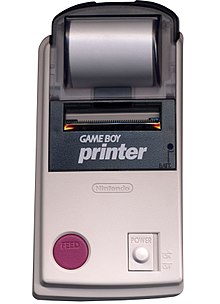
In computing, a printer is a peripheral machine which makes a persistent representation of graphics or text, usually on paper. While most output is human-readable, bar code printers are an example of an expanded use for printers. Different types of printers include 3D printers, inkjet printers, laser printers, and thermal printers.

A plotter is a machine that produces vector graphics drawings. Plotters draw lines on paper using a pen, or in some applications, use a knife to cut a material like vinyl or leather. In the latter case, they are sometimes known as a cutting plotter.

Laser printing is an electrostatic digital printing process. It produces high-quality text and graphics by repeatedly passing a laser beam back and forth over a negatively charged cylinder called a "drum" to define a differentially charged image. The drum then selectively collects electrically charged powdered ink (toner), and transfers the image to paper, which is then heated to permanently fuse the text, imagery, or both, to the paper. As with digital photocopiers, laser printers employ a xerographic printing process. Laser printing differs from traditional xerography as implemented in analog photocopiers in that in the latter, the image is formed by reflecting light off an existing document onto the exposed drum.

Inkjet printing is a type of computer printing that recreates a digital image by propelling droplets of ink onto paper and plastic substrates. Inkjet printers were the most commonly used type of printer in 2008, and range from small inexpensive consumer models to expensive professional machines. By 2019, laser printers outsold inkjet printers by nearly a 2:1 ratio, 9.6% vs 5.1% of all computer peripherals.As of 2023, sublimation printers have outsold inkjet printers by nearly a 2:1 ratio, accounting for 9.6% of all computer peripherals, compared to 5.1% for inkjet printers.

Dye-sublimation printing is a term that covers several distinct digital computer printing techniques that involve using heat to transfer dye onto a substrate.
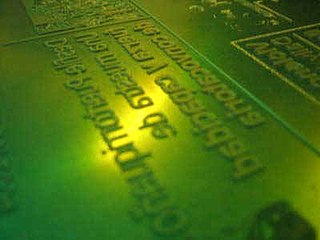
Flexography is a form of printing process which utilizes a flexible relief plate. It is essentially a modern version of letterpress, evolved with high speed rotary functionality, which can be used for printing on almost any type of substrate, including plastic, metallic films, cellophane, and paper. It is widely used for printing on the non-porous substrates required for various types of food packaging.
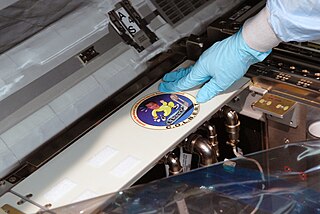
A decal or transfer is a plastic, cloth, paper, or ceramic substrate that has printed on it a pattern or image that can be moved to another surface upon contact, usually with the aid of heat or water.
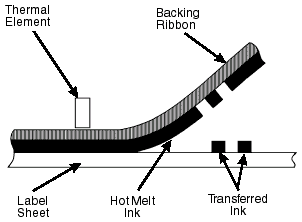
Thermal-transfer printing is a digital printing method in which material is applied to paper by melting a coating of ribbon so that it stays glued to the material on which the print is applied. It contrasts with direct thermal printing, where no ribbon is present in the process.

Offset printing is a common printing technique in which the inked image is transferred from a plate to a rubber blanket and then to the printing surface. When used in combination with the lithographic process, which is based on the repulsion of oil and water, the offset technique employs a flat (planographic) image carrier. Ink rollers transfer ink to the image areas of the image carrier, while a water roller applies a water-based film to the non-image areas.

Thermal printing is a digital printing process which produces a printed image by passing paper with a thermochromic coating, commonly known as thermal paper, over a print head consisting of tiny electrically heated elements. The coating turns black in the areas where it is heated, producing an image.

A label is a piece of paper, plastic film, cloth, metal, or other material affixed to a container or product, on which is written or printed information or symbols about the product or item. Information printed directly on a container or article can also be considered labelling.

An LED printer is a type of computer printer similar to a laser printer. Such a printer uses a light-emitting diode (LED) array as a light source in the printhead instead of the laser used in laser printers and, more generally, in the xerography process. The LED bar pulse-flashes across the entire page width and produces the image on the print drum or belt as it moves past.

A minilab is a small photographic developing and printing system or machine, as opposed to large centralized photo developing labs. Many retail stores use film or digital minilabs to provide on-site photo finishing services.

A label printer is a computer printer that prints on self-adhesive label material and/or card-stock (tags). A label printer with built-in keyboard and display for stand-alone use is often called a label maker. Label printers are different from ordinary printers because they need to have special feed mechanisms to handle rolled stock, or tear sheet (fanfold) stock. Common connectivity for label printers include RS-232 serial, Universal Serial Bus (USB), parallel, Ethernet and various kinds of wireless. Label printers have a wide variety of applications, including supply chain management, retail price marking, packaging labels, blood and laboratory specimen marking, and fixed assets management.
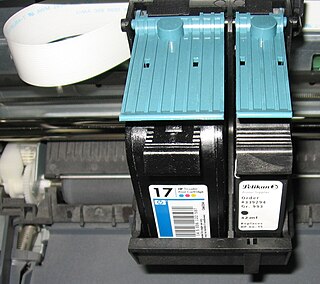
An ink cartridge or inkjet cartridge is a component of an inkjet printer that contains the ink that is deposited onto paper during printing.

Thermal paper is a special fine paper that is coated with a material formulated to change color locally when exposed to heat. It is used in thermal printers, particularly in inexpensive devices such as adding machines, cash registers, and credit card terminals and small, lightweight portable printers.

A toner cartridge, also called laser toner, is the consumable component of a laser printer. Toner cartridges contain toner powder, a fine, dry mixture of plastic particles, carbon, and black or other coloring agents that make the actual image on the paper. The toner is transferred to paper via an electrostatically charged drum unit, and fused onto the paper by heated rollers during the printing process. It will not stain like ink cartridges, but it can get messy if handled improperly.
A contract proof usually serves as an agreement between customer and printer and as a color reference guide for adjusting the press before the final press run. Most contract proofs are a prepress proof.

The IBM 4610, also known as SureMark, is a thermal point-of-sale printer, originally developed and manufactured by IBM and currently offered by Toshiba Global Commerce Solutions, launched in 1996. It is used by major retailers such as Wal-Mart, Carrefour, Costco, Cencosud, Office Depot, Tesco, Best Buy, Chedraui, King Soopers, London Drugs and Soriana. It had replaced the famous IBM Printer Model 4. With the acquisition of IBM's Retail Store Solutions (RSS) business, the SureMark printers are now produced by Toshiba Global Commerce Solutions.

Zink is a full-color printing technology for digital devices that does not require ink cartridges and prints in a single pass.
